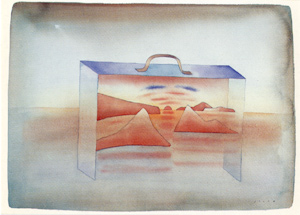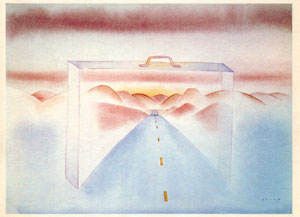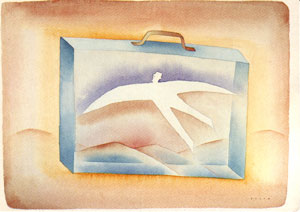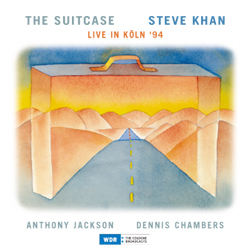

|
Soundclip:
|
| See Steve's Hand-Written Lead
Sheet |
|
Steve
Khan's
lead
sheet : I recalled that, during one of our live performances at Seventh Ave. South, Anthony Jackson had gotten into something that sounded like a human interpretation of a sequencer line. Because it was spontaneous, it had been forgotten. Months later, at a rehearsal, I asked him if he had been working on anything like that, and, what you now see and hear is what he then proceeded to play for us that day.  Steve Jordan and Manolo Badrena immediately joined in,
but the 6/4 time feel initially eluded me. To help me out, in getting a related "groove" for what was
happening, Anthony and Steve played it at half-speed. Eventually, I got it, and that same half-speed
section actually became part of the piece, appearing as sections [I] and [A]. It's
interesting to note that, at half-speed, it seemed that Anthony's theme is interpreted as a 3-bar
phrase in 4/4. Steve Jordan and Manolo Badrena immediately joined in,
but the 6/4 time feel initially eluded me. To help me out, in getting a related "groove" for what was
happening, Anthony and Steve played it at half-speed. Eventually, I got it, and that same half-speed
section actually became part of the piece, appearing as sections [I] and [A]. It's
interesting to note that, at half-speed, it seemed that Anthony's theme is interpreted as a 3-bar
phrase in 4/4.It is also of no small importance to note how Steve Jordan uses the drums [which, in this case, was a hybrid kit with some Simmons electronic drums placed within the natural set] to frame the sections and to bring out the best in the music. At [I] as Anthony's bass theme is being stated, Steve waits until the 5th repeat before entering with just his snare drum played loudly on beat 3. As we hit [A], Steve brings in the full kit, and the impact of his groove is felt. The guitar does not even enter the piece until the 3rd and 4th repeats. The approach [B], in terms of form, is much the same. Anthony, Steve and Manolo vault into the double-time groove and the guitar does not bring in the greater sense of harmony until the 3rd and 4th repeats. These are really arranging issues and in situations like this, where a trust exists between the players, one must listen to all the opinions and do what is best fo the music. The second of the two double-time sections, letter [C], sends Anthony's contrabass guitar into its upper-upper register, as he puts to use his open C-string[indicated on the music by a small circle( ° ) above the note]. Because of the intense 16th-note activity, it seemed that the best option for the guitar was to play "power chords" and so, I played something so simple that it probably, under normal conditions, would have escaped me.  However, this type of solution should be a reasonably obvious option because it safely takes me out of
the range of the contrabass guitar which is, after all, serving a melodic function at that moment. As
the section comes to a cadence on the G2/B sonority, once again something improvised became a
"composed" portion of the piece. The bass line which you see at the top of Pg. 2 was improvised just
once by Anthony, and Steve Jordan immediately picked-up on it, and we went over those two bars
several times until we were all in-synch, and in agreement about how it should be performed. Though it
is a small moment, a small detail, it demonstrates the E.S.P.-like hook-up that exists between Anthony
and Steve. It was always most special to be around that. When you examine the two double-time
sections, [B] and [C], it could easily be said that "The Suitcase" stands as an early virtuoso work for the contrabass guitar.
However, this type of solution should be a reasonably obvious option because it safely takes me out of
the range of the contrabass guitar which is, after all, serving a melodic function at that moment. As
the section comes to a cadence on the G2/B sonority, once again something improvised became a
"composed" portion of the piece. The bass line which you see at the top of Pg. 2 was improvised just
once by Anthony, and Steve Jordan immediately picked-up on it, and we went over those two bars
several times until we were all in-synch, and in agreement about how it should be performed. Though it
is a small moment, a small detail, it demonstrates the E.S.P.-like hook-up that exists between Anthony
and Steve. It was always most special to be around that. When you examine the two double-time
sections, [B] and [C], it could easily be said that "The Suitcase" stands as an early virtuoso work for the contrabass guitar.As it was with much our music, the question would always arise as to if there was truly enough "melodic content" for the piece to survive. If 'intent' is to count for anything, one must remember that in this composition, the bass is carrying the melodic weight. So, the guitar accompaniment and harmonization had to be solid with its own sense of melody, but not enough to detract from the primary focus on the bass. In sharp contrast to the aforementioned sections which were born of Anthony's creativity, the [D] section was something I just seemed to sit down, improvise, and play. I showed it to Anthony, and we then made a couple of small harmonic adjustments, and the piece was fundamentally done. Once we were all in agreement about that section, we knew that having Manolo sing the top notes in vocalese would provide a sharp melodic contrast to having the bass as the sole melodic instrument on the piece. Manolo Badrena has many, many special and unique talents, but one should never discount his voice which has a most special and evocative quality.  This group composition also embodied a portion of just what our 'potential'
could be, because it incorporated elements which are unique to each of us. One can't undervalue the
contributions of Manolo Badrena's percussion concepts here. In addition to the natural sounds he
employed, there are also the Indian tabla samples played via his Pearl Syncussion set-up which
greatly add to the "mood" and the "attitude" of the piece as a whole. This group composition also embodied a portion of just what our 'potential'
could be, because it incorporated elements which are unique to each of us. One can't undervalue the
contributions of Manolo Badrena's percussion concepts here. In addition to the natural sounds he
employed, there are also the Indian tabla samples played via his Pearl Syncussion set-up which
greatly add to the "mood" and the "attitude" of the piece as a whole.Over the many years that have passed since 1981, I have been asked about the sound that I used on this tune, and the "CASA LOCO" album in general. The fundamental guiding principle for me, after the Columbia years(1977-1979) was to go back to a more pure and simple guitar sound. In essence, that was to be a Gibson ES-335 guitar played direct into an amp, and with a little reverb for treatment. Of course, as the music developed from 1981 forward, I had to be more flexible about that, and a Fender Stratocaster appeared on tunes like this one. As the music for this particular album evolved, it just seemed that certain sections needed a little something extra, and so, on this album, that sound was produced with the help of the Ibanez Chorus(CS9). This particular pedal was a bit noisy sounding, not ideal for a high-quality audio recording, but it was in stereo, and was played through two Roland JC-120s. If you read below about the performance of "The Suitcase" on the double-live album, "THE SUITCASE" from 1994, the major sonic difference, apart from the fact that I had to play it on my Gibson 335 as I couldn't afford to travel with two guitars, is that then I had graduated to what became my true sonic voice, where effects are concerned, the Ibanez Digital Chorus/Flanger(DCF-10) which I have written about extensively at the EQUIPMENT page here. This spirit of cooperation between Anthony Jackson; Steve Jordan; Manolo Badrena and I gave me so much hope for the future of this music and our group. Here, as we often did, we mix elements of Latin music, R&B, Rock, Jazz, World Music, and probably other things I can't think of in this moment. No matter what kind of music I participated in before, nor what I might have done since, nothing can compare to the most special group chemistry that existed here. I have said this before, but I can't ever say it enough. Whatever I have become as a musician, I owe so much of that to having had the privilege of spending so much time working with Anthony Jackson, Steve Jordan, and Manolo Badrena. They are and will remain as three of the most gifted and unique spirits playing music!!! Addendum: With the release in 2008 of "THE SUITCASE," a double live CD with Anthony Jackson and Dennis Chambers, recorded in Köln, Germany and originally for a WDR radio broadcast on May 17th, 1994, I believe that it becomes necessary to revisit the analysis pages related to the 9 original tunes that appear on the recording.  Yes, for the tunes that appeared on the original "CASA LOCO" recording from 1983, some 11 years had passed, but the performances you now hear represent the growth of the music through live playing and improvising. In most cases, what you now hear on this CD will be much closer to the lead sheets that you've been viewing since the launching of the website in September of 1998. Yes, for the tunes that appeared on the original "CASA LOCO" recording from 1983, some 11 years had passed, but the performances you now hear represent the growth of the music through live playing and improvising. In most cases, what you now hear on this CD will be much closer to the lead sheets that you've been viewing since the launching of the website in September of 1998.Without a doubt, one of the most spectacular moments during this 'live' performance was Anthony's "prelude" to the composed portion of the piece. To tell all of you the truth, I don't know that Anthony performed something like this at any of the other concerts during the tour. As the tour was being organized, Anthony made a point of asking that two Lexicon 224 reverb units would be present at each venue. Of course, this request was almost never answered! However, it is apparent, by the sounds produced during the live recording, and the fact that those Lexicon units are visible in the group photo within the CD booklet, I guess his prayers were answered at least twice! The prelude shows Anthony's imagination, and influences from the Neo-Classical side of his leanings in full force. I have listened to this performance many times and, once I start down the road with A.J., I am always fascinated by the twists and turns that he takes on this journey. I am thrilled that this happened that night, and that it is presented here. I hope that everyone who hears it will experience it as I do. And that is with awe and reverence! The performance of the tune itself is also full of imagination and power. Again, not to overstate it, the absence of Manolo's colors and flavors are missed but there is no absence of energy, nor power. And the dynamics of the trio are in full display. A simple and basic element of good music, of good music-making, but an element which is often under valued. I can't close this chapter without expressing what a great thrill it is for me to finally be able use "The Suitcase" as a CD title, and, more than this, that one of Jean-Michel Folon's beautiful watercolors graces the cover. In a sense, now the cycle has been completed.
|